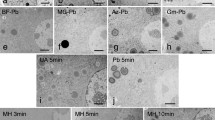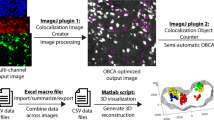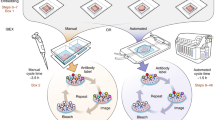Abstract
WHILE radioactive isotopes have found valuable application in many cytochemical studies of metabolic incorporation processes, little use has so far been made of such labels in cytochemical reactions applied directly to the localization of substances in tissue specimens. Some qualitative applications to enzymic cytochemistry, for example, using metals or phosphorus-32 in deposited products, have been reported1. We have now examined the applicability of tritium-labelled reagents which form covalent bonds at specific sites in tissue components, as a method in quantitative cytochemistry. The advantages of such a method will include, inter alia (cf. ref. 2): (1) an escape from some of the problems of selectively introducing sufficient light-absorption at specific sites, since the label can be carried on many suitable simple reagent molecules; (2) autoradiographic measurement, which is free of certain of the problems of micro-spectrophotometry and is independent of the molecular environment of the target sites; (3) checks and calibrations of micro-spectrophotometric methods for the same components, and the possibility, at least in principle, of absolute determinations.
This is a preview of subscription content, access via your institution
Access options
Subscribe to this journal
Receive 51 print issues and online access
$199.00 per year
only $3.90 per issue
Buy this article
- Purchase on Springer Link
- Instant access to full article PDF
Prices may be subject to local taxes which are calculated during checkout
Similar content being viewed by others
References
For example, Dalgaard, J. B., Nature, 162, 811 (1948). Shugar, D., Szenberg, A., and Sierakowska, H., Exp. Cell. Res., 13, 424 (1957). Pearse, A. G. E., Biochem. J., 68, 17 P (1958).
Barnard, E. A., in “New Approaches in Cell Biology”, edit. by Walker, 145 (Acad. Press, New York, 1960).
Barnard, E. A., in “General Cytochemical Methods”, edit. by Danielli, 2 (Acad. Press, New York) (in the press).
Pelc, S. R., Internat. J. App. Rad. Isotopes, 1, 172 (1956).
Fitzgerald, P. J., Eidinoff, M. L., Knoll, J. E., and Simmel, E. B., Science, 114, 494 (1951).
Davies, H. G., in “General Cytochemical Methods”, edit. by Danielli, 1, 57 (Acad. Press, New York, 1958).
Fraenkel-Conrat, H., Bean, R. S., and Lineweaver, H., J. Biol. Chem., 177, 385 (1949).
Author information
Authors and Affiliations
Rights and permissions
About this article
Cite this article
BARNARD, E., MARBROOK, J. Quantitative Cytochemistry using Directly Applied Radioactive Reagents. Nature 189, 412–413 (1961). https://doi.org/10.1038/189412a0
Issue Date:
DOI: https://doi.org/10.1038/189412a0
Comments
By submitting a comment you agree to abide by our Terms and Community Guidelines. If you find something abusive or that does not comply with our terms or guidelines please flag it as inappropriate.



